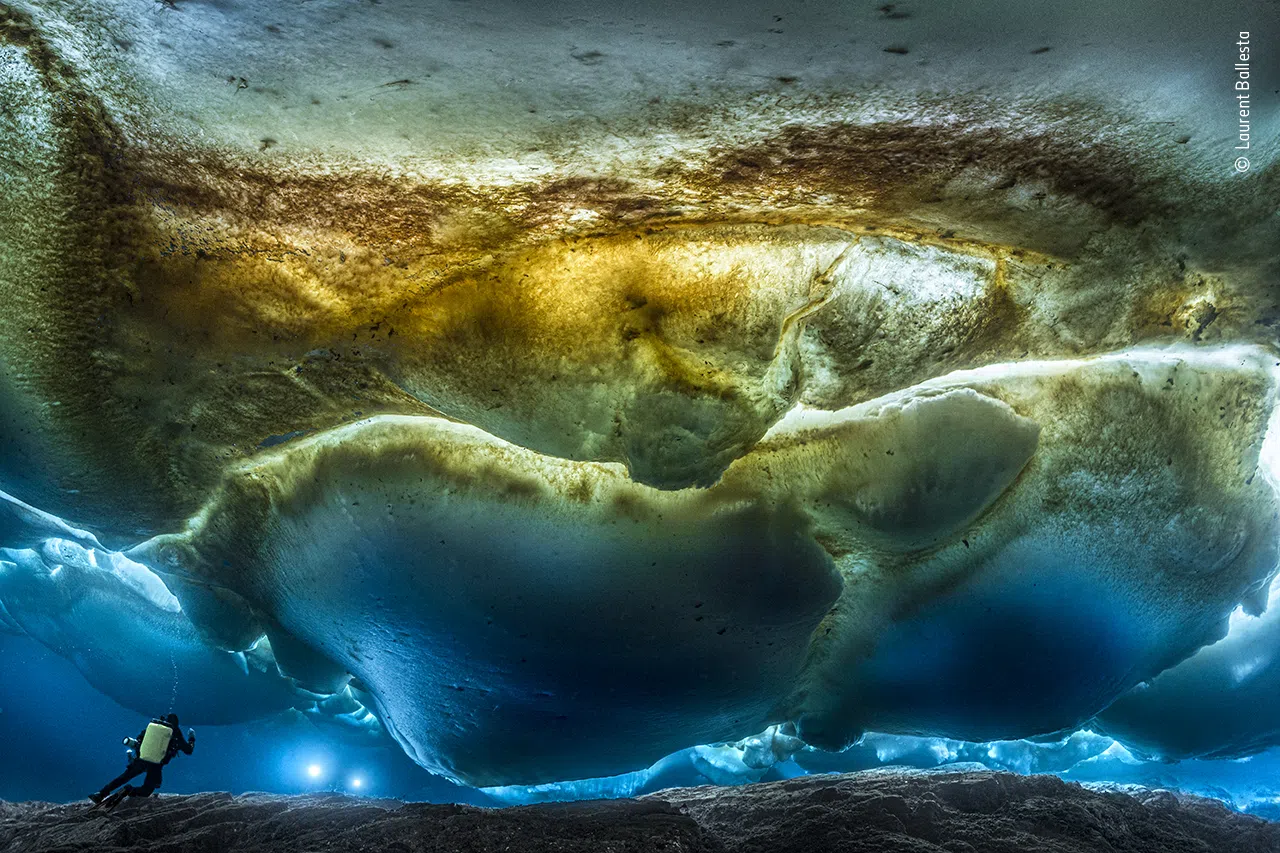London’s Natural History Museum conducts a Wildlife Photography competition every year.
This year’s winners have just been announced. We present the two winning images and some of the other finalists. The entire gallery of finalists and winners, along with a description of the image and why it won, can be found here. Do take a look!
All images from the gallery of Natural History Museum.
The Big Buzz: Winner

Karine Aigner (USA) gets close to the action as a group of cactus bees compete to mate.
Using a macro lens, Karine captured the flurry of activity as a buzzing ball of cactus bees spun over the hot sand on a Texas ranch. It was May, and having emerged from their birth burrows, the male bees were ready to mate.
Once mated, a female will feed mainly on cacti pollen and nectar, then wait out the year until next spring. As soon as the prickly pear and cholla cacti start to flower again, the mated females converge on a flat sandy area and start burrowing. It was the volcano‑like turrets of their individual burrows that led Karine to discover the presence of the nesting aggregation.
The Beauty of the Baleen: Young Winner

Katanyou Wuttichaitanakorn (Thailand) is intrigued by the contrasting colours and textures of a Bryde’s whale, surfacing close by.
Whale watching has become a popular activity in the Gulf of Thailand, focused on a population of Bryde’s whales that are present all year round in the South China Sea.
Bryde’s whales have up to 370 pairs of grey-coloured plates of baleen growing inside their upper jaws. The plates are made of keratin, a protein that also forms human hair and nails, and are used to filter small prey from the ocean.
Night Hunter

Angel Fitor was surprised by this octopsus entangling his camera.
Atlantic white‑spotted octopuses are gentle hunters, finding their food either by touch or by shooting jets of water.
Arctic Ambush

Theo Allofs (Germany) follows a polar bear as it hunts for prey among the ice floes.
Theo had sailed for days through loose pack ice before spotting the lone polar bear. Approaching the sleeping bearded seal, the bear dived down before rocketing out of the water, propelling its body onto the ice floe. It missed its target and the seal escaped into the water.
Bear Bonanza

Adam Rice (USA) watches sockeye salmon evading a hungry brown bear.
After finding the perfect vantage point to convey the struggle, Adam caught the Sun at the perfect angle to light the scene. This bear’s strategy of repeatedly swimming through a vast school might not have been the best, as Adam observed how ‘the fish always seemed just out of reach’.
The Spore Spell

Can you guess what this is? It’s not a galaxy or nebula captured by a telescope.
Imre Potyó (Hungary) conjures a magical moment from the forest floor.
Imre arrived at dusk in search of a ripe fungus. When darkness fell, he gently tapped it hoping to capture random patterns backlit with his flash. To his delight the air flow obliged, creating ephemeral trails as the puffball cast its spores into the forest night.
Many puffballs have a crusty surface that, at maturity, develops a small opening at the top. When heavy rain hits the puffball, millions of tiny spores stream out to be swept away on the breeze.
House of Bears

Dmitry Kokh (Russia) presents this fairy tale image of polar bears shrouded in fog at the long-deserted settlement on Kolyuchin.
Polar bears are curious by nature and intelligent hunters. In the Chukchi Sea region, these usually solitary bears migrate further north in the summer, following the retreating sea ice and their main prey – seals.
The Green, Green Grass

Aren’t golf courses just beautiful? Bright green grass as far as the eye can see and lovely greenery. Ever wondered how the grass on the golf course is so unlike grass found anywhere?
This drone picture tells us why (and what it does).
Ignacio Medem (Spain) highlights the bright green golf-putting green against the River Piedra marshes.
Using drone photography, Ignacio shows us how the pesticides and fertilisers used in golf courses run off into the wider environment, potentially damaging the marshes.
The Stained-Glass landscape of ice

This picture is my personal favourite! For just the sheer scale that it represents.
Laurent Ballesta (France) endures below-freezing dives to reveal the diversity of life beneath Antarctica’s ice.
Laurent’s team navigated the freezing maze, where the ice could move at any moment and leave them trapped. To convey the immensity of the icescape streaked by colourful algae, Laurent stitched together a panorama of 24 images.
‘For this to work,’ he explains, ‘it was essential for us all to keep very still’. After one of his team entered the scene, contributing scale and a dynamic bubble trail, Laurent captured the light filtering through the tinted ice like a stained-glass window into another world.
The Octopus Case

Samuel Sloss (Italy/USA) is spotted by a coconut octopus, peeking out from a clam shell.
Samuel was muck diving along the volcanic sands of Lembeh Strait, Indonesia, when he noticed this coconut octopus. He lowered the power of his strobe lamp so as not to distress it. As he approached, the octopus quickly shut the lid of the shell, but then, to Samuel’s delight, it slowly opened it again, revealing a stunning array of colours and coils.
This small octopus feeds mainly on shrimps, crabs, clams and small fish. To protect its soft body, it employs a sophisticated defence strategy – finding, cleaning, and carrying shells or other suitably sized objects to hide in.
In some cases, these octopuses have even been known to use coconut shells. Carrying such large objects requires most of their tentacles, and so they travel by ‘walking’ on just their front two tentacles.
Earlier Winners
You can see previous winners here:

